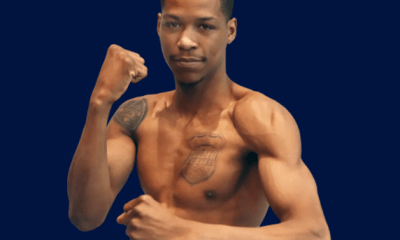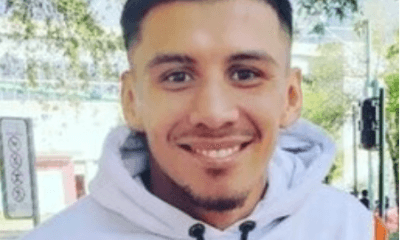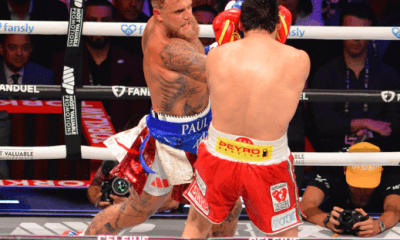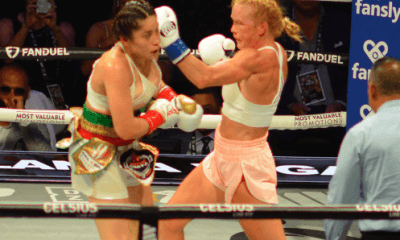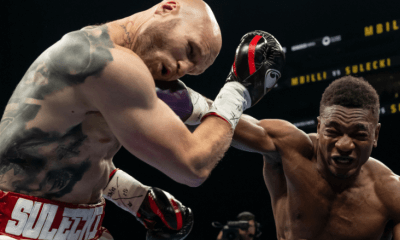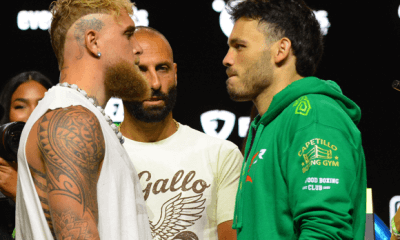Featured Articles
2018 Awards Rush: Some Worthy Candidates Too Late to Join Party

There was a commercial for a particular brand of coffee that once advised the public that its brewed product was “good to the last drop.”
And so it is with the overseers of many boxing publications and web sites, who, best intentions aside, might now seem oblivious to the fact that the Chicago Tribune, in its haste to be first at the possible expense of being right, infamously printed the front-page headline that “Dewey Defeats Truman” in its Nov. 3, 1948, editions. Oops, Harry S Truman, not Thomas Dewey, actually won that presidential election when all of the nation’s votes were counted.
The Tribune’s legendary rush to judgment, alas, has been repeated or at least hinted at in years since, reinforcing the late Spanish philosopher and essayist George Santayana’s sage observation that those who cannot remember the past are doomed to repeat it. On July 6, 2004, the New York Post, based on supposedly unimpeachable sources, “beat” all other news outlets when it ran a front-page headline advising readers that Democratic presidential candidate John Kerry had chosen Missouri Congressman Richard Gephardt to be his running mate. But as is the case in Aesop’s Fables, in which the slow and steady tortoise finds a way to beat the hare to the finish line, some races do not go to the swift; the following day the Post sheepishly joined all those smug stragglers in revealing that Kerry’s actual pick was North Carolina Senator John Edwards.
The far-flung events of Dec. 22, in boxing rings in America and the United Kingdom, again demonstrated that a calendar year consists of 365 days, not 355, and it might be best not to make any announcements until all the precincts have reported and the New Year is ushered in by that big ball dropping in Times Square at the stroke of midnight.
In keeping with tradition that might now need to be reconsidered, the Boxing Writers Association of America, which I once served as president and continue to serve as awards chairman, held separate business meetings in Los Angeles and New York in December in which nominations for the BWAA’s annual awards were submitted by members in attendance. The votes from both meetings are the basis for formulating final ballots in each of the categories. For what it’s worth, there is a time imperative to start the ball rolling some weeks before the end of the year, the better to begin the process of collecting the votes of eligible electors, announcing the winners and, in the BWAA’s case, arranging for said winners to attend the BWAA Awards Dinner, the date and site of which usually have not been determined that far in advance. Some awards require significant lead time to prepare.
The Sweet Science also has its “Best of” awards in any given year, as do ESPN, The Ring and any number of other media outlets that don’t want somebody else, or several somebodies, to jump to the front of the line. It’s understandable, and it explains why, on election night, major news networks project certain candidates to be winners even if small percentages of the votes have been tabulated. Usain Bolt might not have won all those Olympic gold medals if other sprinters were allowed to get away with false starts. And, far more often than not, getting there first often is still the correct call.
But Dec. 22 proved that the current system employed by many media outlets is not infallible. TSS’ choice for Knockout of the Year, 21-year-old lightweight Teofimo Lopez’s first-round knockout of Mason Menard on Dec. 8, was posted on this site on Dec. 20 and under normal circumstances might be considered a no-brainer. Lopez’s overhand right landed with such concussive force that Menard was out cold before he plunged on the canvas in the first round, a kayo so emphatic that it reinforced Lopez’s burgeoning reputation as a big hitter and star-in-the-making. Only two weeks later, however, highly regarded heavyweight contender Dillian Whyte, who had traded bombs with Dereck Chisora from the opening bell, delivered a turn-out-the-lights left hook in the 11th round in London that sent Chisora sprawling onto his back, every bit as knocked out as Menard had been.
As exclamation-point finishes go, there might not be much to choose between Lopez’s crushing of Menard and Whyte’s wipeout of a very game Chisora. But consider this: Whyte trailed, 95-94, on two of the three official scorecards at the time he landed that haymaker of a hook (Chisora was ahead by the same margin on the other card), and with the victory he might have vaulted ahead of Jarrell “Big Baby” Miller as the next opponent to be faced by IBF/WBA/WBO heavyweight champion Anthony Joshua on April 13 in London’s Wembley Stadium. Given the possible implications of a Joshua-Whyte rematch – Joshua stopped Whyte in a dandy fight for the vacant British heavyweight title on Dec. 12, 2015 – would that have been enough to have slid Whyte-Chisora II (another rematch of an exciting original) in ahead of Lopez-Menard? It’s a moot point now, but worth considering.
Nor is Whyte-Chisora II a candidate for BWAA Fight of the Year, which most might assume would have been the case if that ballot had not been finalized beforehand. TSS’ pick for Fight of the Year, the Gennady Golovkin-Canelo Alvarez rematch, is a reasonable enough choice, and that hugely consequential clash for middleweight supremacy likely will go head-to-head for the designation from the BWAA with the epic Deontay Wilder-Tyson Fury draw and Jarrett Hurd’s rousing, split decision over Erislandy Lara in their super welterweight unification showdown.
At least Wilder-Fury has a chance at being voted BWAA Fight of the Year. For the fighters themselves, mere participation in such a classic apparently doesn’t count for much, as is often the case when draws are involved. Although attendees at both BWAA business meetings, which took place prior to Wilder-Fury, nominated the winner for a place on the Fighter of the Year ballot, there was no winner, although backers of each man have their own thoughts about that. If nothing else, Wilder-Fury I – there has to be a do-over soon, right? – proved that it is possible to not only have an individual or a team lose on a tie, but for both parties to do so.
At least TSS’ Upset of the Year – Eleider Alvarez’s seventh-round knockout of favored WBO light heavyweight titlist Sergey Kovalev – left no doubt as to whom the winner was, or deserved to be. Were it not for the way that fight ended, Tony Harrison’s disputed unanimous- decision dethronement of WBC super welterweight champion Jermell Charlo, also on Dec. 22, and in Brooklyn’s Barclays Center, might have entered into the discussion.
No system for determining, well, anything is flawless. There isn’t always enough time to do a job perfectly, no matter how much we might wish to, not with budget restrictions and deadline pressure complicating the process. On Dec. 22, a day that might have altered at least some people’s perception of a couple of End-of-Year awards, 96.98 percent of the year’s boxing business already had been concluded. It might not seem like there was much time to squeeze in a very late surprise here or there, but it left a heck of a lot more room for revision than is given to anyone who purchases a Powerball Lottery ticket.
But someone occasionally wins the big Powerball prize, and maybe even will do so when the numbered ping pong balls come up again on Dec. 26. A hopeful ticket holder could learn that his longest of long shot dreams have come true the day after Christmas, but so what? Like they say, better late than never.
Bernard Fernandez is the retired boxing writer for the Philadelphia Daily News. He is a five-term former president of the Boxing Writers Association of America, an inductee into the Pennsylvania, New Jersey and Atlantic City Boxing Halls of Fame and the recipient of the Nat Fleischer Award for Excellence in Boxing Journalism and the Barney Nagler Award for Long and Meritorious Service to Boxing.
Check out more boxing news on video at The Boxing Channel
To comment on this article in the Fight Forum, CLICK HERE
-

 Featured Articles3 weeks ago
Featured Articles3 weeks agoAvila Perspective, Chap. 330: Matchroom in New York plus the Latest on Canelo-Crawford
-

 Featured Articles2 weeks ago
Featured Articles2 weeks agoVito Mielnicki Jr Whitewashes Kamil Gardzielik Before the Home Folks in Newark
-
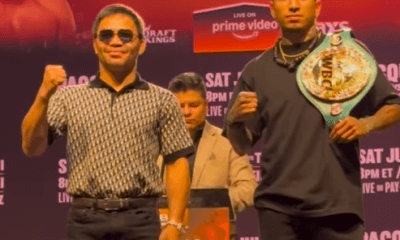
 Featured Articles4 weeks ago
Featured Articles4 weeks agoAvila Perspective, Chap 329: Pacquiao is Back, Fabio in England and More
-
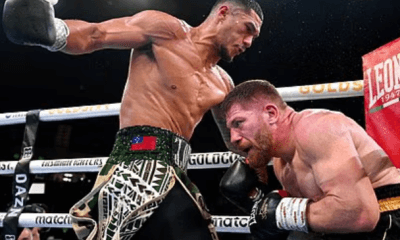
 Featured Articles3 weeks ago
Featured Articles3 weeks agoOpetaia and Nakatani Crush Overmatched Foes, Capping Off a Wild Boxing Weekend
-

 Featured Articles2 weeks ago
Featured Articles2 weeks agoCatching Up with Clay Moyle Who Talks About His Massive Collection of Boxing Books
-

 Featured Articles4 weeks ago
Featured Articles4 weeks agoFabio Wardley Comes from Behind to KO Justis Huni
-

 Featured Articles1 week ago
Featured Articles1 week agoMore Medals for Hawaii’s Patricio Family at the USA Boxing Summer Festival
-
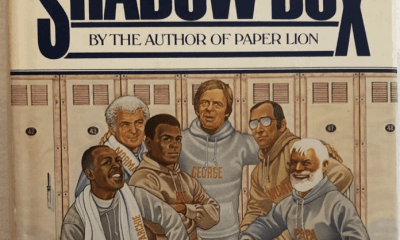
 Featured Articles4 weeks ago
Featured Articles4 weeks agoDelving into ‘Hoopla’ with Notes on Books by George Plimpton and Joyce Carol Oates

